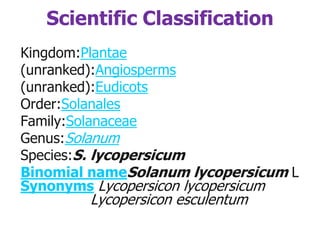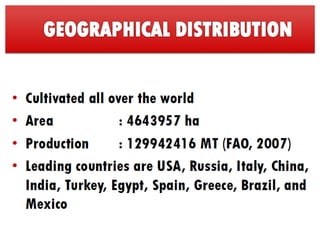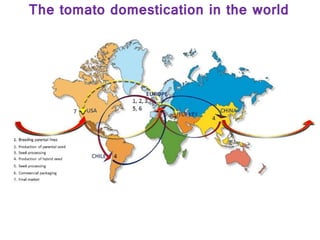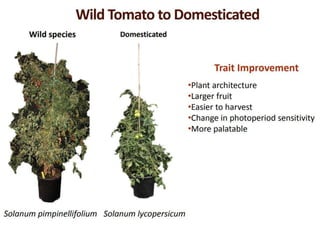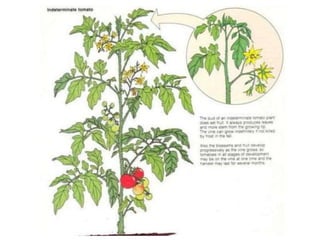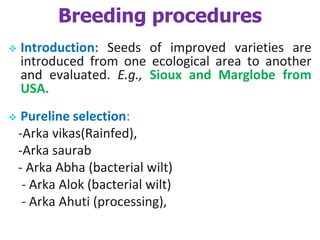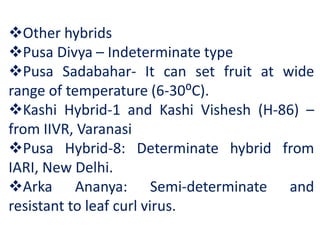Tomato breeding
- 1. Tomato
- 2. Botanical classification In 1753, Linnaeus placed the tomato in the genus Solanum (alongside the potato) as Solanum lycopersicum. However, in 1768 Philip Miller moved it to its own genus, naming it Lycopersicon esculentum. This name came into wide use but was in breach of the plant naming rules. Technically, the combination Lycopersicon lycopersicum (L.) H.Karst. would be more correct, but this name (published in 1881) has hardly ever been used (except in seed catalogs, which frequently used it and still do).
- 3. Scientific Classification Kingdom:Plantae (unranked):Angiosperms (unranked):Eudicots Order:Solanales Family:Solanaceae Genus:Solanum Species:S. lycopersicum Binomial nameSolanum lycopersicum L Synonyms Lycopersicon lycopersicum Lycopersicon esculentum
- 4. The word "tomato" comes from the Spanish word “tomate”, meaning "the swelling fruit".
- 5. Importance Second most consumed vegetable after potato in the world First in terms of total contribution of nutrients to human diet among vegetables Consumed in fresh form and various processed forms like soup, sauce, ketchup, paste, puree, canned etc. Tops the list of processed vegetables Also an ideal model plant for physiological, biochemical, cytological and molecular investigations Tomato has very few competitors in the value addition chain of processing. it is rich in citric acid and mallic acid and contains minerals like Na,P, K,Ca,Mg.
- 9. In India, tomato grown in an area 4.58 lakh ha. And 74.62 lakh tonns respectively with a productivity of 16.29 tonns / ha. The leading producing states are UP, Karnataka, Maharashtra, Gujrat, Punjab, Haryana and Bihar.
- 10. Origin and Evolution Originated in the New World (South America) specifically to the Andean region encompassed by parts of Chile, Columbia, Ecuador, Bolivia and Peru. Immediate ancestor : L. esculentum var. cerasiforme (wild cherry tomato) The tomato was spread around the world following the Spanish colonization of the Americas, and its many varieties are now widely grown, often in greenhouses in cooler climates. Gradual evolution of the large fruited types and shift from allogamy to autogamy under domestication.
- 11. The tomato domestication in the world
- 14. The cultivated tomato, Solanum lycopersicum L., is a member of the small section Lycopersicon along with its 12 wild relatives. Solanum lycopersicum is the only domesticated species An additional four species from sections Juglandifolia and Lycopersicoides are traditionally considered as tomato wild relatives. These species are all endemic to South America, but the cultivated tomato itself has achieved worldwide distribution with the help of human populations.
- 15. Origin: Peru and Mexico Distribution: Europe, USA, India, Japan and China. In India it is grown in all the states Other species: S. pimpinellifolium - Fusarium wilt, early blight resistant S. peruvianum - Leaf curl virus resistant S. cheesmanii - Salt resistant S. hirsutum - Fruit borer resistant S. pennellii - Drought and salinity tolerant S.chilense - Gemini virus resistant S.habrochaites - Cold tolerance and Insect resistance
- 17. Species 1. Eu lycopersicon. 2. Erio persicon. Eu lycopersicon is characterized by red fruited edible species with carotinoid pigmentation and they are annuals. Cultivated tomato is included in this. The species included are 1. Cultivated tomato - Licopersicon esculentum 2. Small fruited tomato- Licopersicon pimpinellifolium Eriopersicon is characterized by green fruited species, anthocyanin pigmentation. The species included are peruvianum, hirsutum, persicae and glandulosum, cheesmanii.
- 18. Breeding objectives Breeding for earliness Breeding for increased fruit yield Fruit quality like large round, uniform size, deep red colour and increased shelf life etc. Breeding for disease resistance Fusarium wilt, Verticillium wilt, Late blight, Early blight, Septoria leaf spot, Anthracnose, Bacterial wilt, Bacterial canker, Tomato mosaic virus, Root knot nematode.
- 19. Breeding for insect resistance (fruit borer, whitefly etc). Breeding for abiotic stresses (cold tolerant, drought tolerant, salt tolerant, low temperature tolerant, herbicide tolerant). To breed varieties for prolonged storage and transportation To breed varieties suitable for processing Indeterminate cultivars for greenhouse production
- 22. Breeding procedures Introduction: Seeds of improved varieties are introduced from one ecological area to another and evaluated. E.g., Sioux and Marglobe from USA. Pureline selection: -Arka vikas(Rainfed), -Arka saurab - Arka Abha (bacterial wilt) - Arka Alok (bacterial wilt) - Arka Ahuti (processing),
- 23. Single plant selection: single plant selection is used to select chance variants, off types, superior types from mixed homozygous population in self pollinated vegetable crops. This is one of effective method to make maximum use of germplasm. Eg: Earliana, Greater Baltimore and Bonny Best. Mass selection: Massing of IIHR-674 from VC-82 line from USA developed in to Arka Ashish (processing). Pedigree Method : Eg: Arka Meghali of tomato PS (F8 ) of Arka Vikas x IHR 554 Pusa Ruby selection from Improved Meeruti x Sioux Single seed decent method
- 24. Heterosis breeding : Though, tomato a self pollinated crop has a tremendous potential for heterosis breeding. The commercial exploitation of hybrid vigour in tomato has received greater importance on account of several advantages of hybrids over pure line varieties with response to marketable fruit yield and its component traits as well as resistance to biotic and abiotic stresses. Released F1 Hybrids: Arka Vishal (IHR-837 X IHR-932) Arka Vardan: IHR-550-3 X IHR-932 Arka Shreshta: 15-SBSB X IHR-1614 Arka Abhijit: 15-SBSB X IHR-1334
- 25. Interspecific Hybridization: S. peruvianum – Source of Resistance to Verticillium wilt, Tomato leaf curl virus, Nematodes and Salinity. S. pimpinellifolium – Source of Resistance to bacterial wilt, Fusarium wilt. Source of carotene and Vit-C content. S. hirsutum - Source of Resistance to Fusarium wilt, Helicoverpa insect and Virus. S. cheesmani - Good source for salinity resistance. S. pennelli - Drought resistance and salinity resistance. Mutation Breeding: S12 (Pusa S12) – Sioux variety is exposed to mutation. Pusa Lal Meeruti – From Improved Meeruti.
- 26. Breeding for Storage life and Processing type Fruits with high acidity, uniform intense red colour, high TSS (Total soluble solids), resistance to cracking, elongated fruits with high yield. Plants should be adopted to mechanical harvesting with determinate habit, concentrated fruit set for once harvesting only and jointless pedicel on fruit etc. Varieties – Roma, Punjab Chuhara, Arka Ahuti, Arka Ashish Juice and Canning purpose: Roma, Son Marzano, Red Top, HS-110 Paste and Ketchup: HS 101, HS 110.
- 27. Breeding for Resistance to Diseases Bacterial wilt: Arka Abha, Arka Alok, PI 127805-A (L.pimpinellifolium) Leaf Curl Virus : L. peruvianum & L. hirsutum. Resistant Varieties: Nandi, Vaibhav, Sankranthi. Nematodes: PI 128657 (L.peruvianum), Neematex (not infected by all three races of RKN), Arka Vardan (F1 hybrid), NTDR-1, PNR-7, Pusa-120 etc. Hybrids : Determinate type: ARTH-3, Pusa Hybrid-2, NARF-101, Swarna-12, NDTH-6, Nath Amruth-501, DTH-4 Indeterminate type: ARTH-4, FM-2, KT-4, MTH-6,FM-1, Nath Amruth-601, NDTH-2.
- 28. Other hybrids Pusa Divya – Indeterminate type Pusa Sadabahar- It can set fruit at wide range of temperature (6-30⁰C). Kashi Hybrid-1 and Kashi Vishesh (H-86) – from IIVR, Varanasi Pusa Hybrid-8: Determinate hybrid from IARI, New Delhi. Arka Ananya: Semi-determinate and resistant to leaf curl virus.
- 29. Biotechnological methods: (i)Antisense RNA for Polygalactourinase (PGU) enzyme. (The cell wall degrading enzyme. Activity appears at the onset of ripening and in ripe fruit it is one of the major cell- wallbound proteins.) Eg. FLAVR SAVR Variety available in market. (ii) Viral Coat Protein – Introduced gene which can synthesize the protein which coats the virus material. Eg. Avinash-1 and Avinash-2 varieties. (iii) Herbicide Resistance:- Gene which can resist that herbicide. Means variety should not be affected but weeds should be cleared. (iv) Insect Resistance: Eg. ‘Bt’ for Helicoverpa(fruit borer) resistance.
- 30. Flavr Savr, a genetically modified tomato, was the first commercially grown genetically engineered food to be granted a license for human consumption.
- 31. Flavr Savr (pronounced "flavor saver"), was produced by the Californian company Calgene. Characteristics Through genetic engineering, Calgene hoped to slow down the ripening process of the tomato and thus prevent it from softening, while still allowing the tomato to retain its natural colour and flavour. This would allow it to fully ripen on the vine and still be shipped long distances without it going soft. The Flavr Savr was made more resistant to rotting by adding an antisense gene which interferes with the production of the enzyme polygalacturonase. The enzyme normally degrades pectin in the cell walls and results in the softening of fruit which makes them more susceptible to being damaged by fungal infections. Flavr Savr turned out to disappoint researchers in that respect, as the antisensed PG gene had a positive effect on shelf life, but not on the fruit's firmness, so the tomatoes still had to be harvested like any other unmodified vine-ripe tomatoes.



